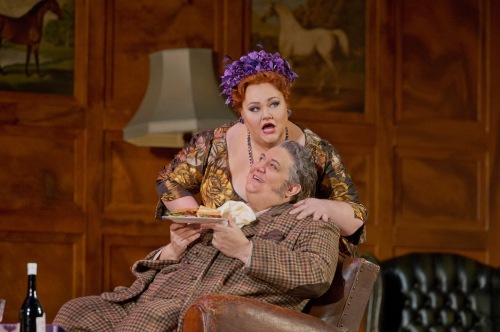Five long and convoluted plots make up the majority of this restoration comedy. The major thread running throughout turns the usual rakishness on it’s head and postulates a Female Falstaff, a direct descendant of his who has been given the rather unimaginatively named Duchy of Notwit (a corruption of “not wet” typical of the most ostentatious restoration sexual jokes).
She sets out to outdo her famous relatives apparent seduction score of seven. She manages three during the action of the play, but the epilogue suggests there were originally several more plays within the cycle that either have been suppressed or were lost with the changing of theatre-going appetites. Two of the three main men seduced by the Duchess of Notwit are involved in an ongoing feud over a woman who is one of the Duchess’ intended targets.

The Duchess of Notwit, in one rather pleasing “banquet scene”, offers a defense of epicurean delight, suggesting to one of her lover’s that they might be delighted in perpetual edibility. This scene informed Salvador Dali’s development of Les Diners de Gala.
Everyone seems to have a romantic dalliance with everyone due in part to some plot they have explained in detail to their servants, who all operate as the Plautine style clever slave, which means the plans they make keep tripping over each other.
Jaques Lacan’s original notes towards his Seminar on “The Purloined Letter” indicate that he meant to use the signifiers present within this play, but his diagrams in the manuscript ballooned further and further outwards into a ball of arrows all connecting back and forth with each other. He attempting several times to piece out the plot of this play, only to give up each time: the essence of the signifier escaped him, always seeming to be some other.

Most of the other plots likewise involved the sexual politics of the day, and are less well regarded, with the exception of the woman who dresses in male breeches who is revealed to have been a male actor all along to find that the person she settles for (instead of her intended amour, who chases Notwit) was
“born between the sexes, preferring both, taking on either when needed, but appealing to and aspiring to a difference of none.”
This pun is further taken into lasciviousness by the immediate retreat of the two lovers to a far off convent– an idea picked up later by The Marquis de Sade.
As for the authorship of this play, it is suspected that de Vailles-Villages is a cipher for some peer of the realm, a regular at court, who is writing en femme (which, rather jou·is·sance-lly ) may indeed have been the writer’s position at court, the King’s official girl.
